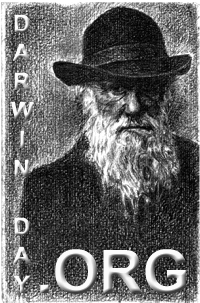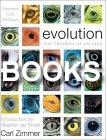|
- Human Evolution You Figure it Out! Sites with simple clear logic so that even creationists can understand. |

Join the
celebration
February
12th

Check
the AiS collection of books on evolution
&
related science.

PBS Evolution
Video explores the scientific meaning of the word "theory"
|
What
is Science ?
An
article on the Talk.Origins site with a brief explanation of the
concept of science and scientific evidence......
Creationists confuse and misuse (and often deliberately) the terms ontological (philosophical) naturalism and methodological naturalism. The former is the view that nothing supernatural exists - a point which may engender heated debate among theologians and philosophers but is irrelevant to the pursuit of science....... http://www.answersinscience.org/MethodologicalNaturalism.htm
The PBS website containing a multitude of resources to help answer this question........ http://www.pbs.org/wgbh/evolution/library/09/index.html
One of the more concise definitions of science I have seen was that given by Edward O. Wilson and published in the American Scientist, Jan/Feb 1998, pg.6. "Science, ... is the organized systematic enterprise that gathers knowledge about the world and condenses the knowledge into testable laws and principles. The diagnostic features of science that distinguish it from pseudoscience are first, repeatability: The same phenomenon is sought again, preferably by independent investigation, and the interpretation given to it is confirmed or discarded by means of novel analysis and experimentation. Second, economy: Scientists attempt to abstract the information into the form that is both simplest and aesthetically most pleasing the combination called elegance while yielding the largest amount of information with the least amount of effort. Third, mensuration: If some thing can be properly measured, using universally accepted scales, generalizations about it are rendered unambiguous. Fourth, heuristics: The best science stimulates further discovery, often in unpredictable new directions; and the new knowledge provides an additional test of the original principles that led to its discovery. Fifth and finally, consilience: The explanations of different phenomena most likely to survive are those that can be connected and proved consistent with one another.
Finally, excerpted below is D. J. Daniels' web site http://home.earthlink.net/~dayvdanls/whatsscience.html, containing a collection of some rather excellent definitions. Science can be defined in a number of ways. Webster's Dictionary defines science as "the observation, identification, description, experimental investigation, and theoretical explanation of natural phenomena."The following definition of science was agreed upon by 72 Nobel laureates. (From the Amicus Curiae presented in the US Supreme Court Case of Edwards vs Agullard, 1986) "Science is devoted to formulating and testing naturalistic explanations for natural phenomena. It is a process for systematically collecting and recording data about the physical world, then categorizing and studying the collected data in an effort to infer the principles of nature that best explain the observed phenomena."The essential characteristics of science are:
It has to be explanatory by reference to natural law. It is testable against the empirical world. Its conclusions are tentative (are not necessarily the final word). It is falsifiable (Ruse, from Montagu, pg. 340) The processes whereby scientific theories are supported or rejected is called the Scientific Method. In most science classrooms students are told that this process can be broken down into the following steps:
Research the question to determine how much is already known about it. Propose a solution to the question (HYPOTHESIS) which may explain it. A hypothesis is an imaginative preconception of what might be true in the form of a declaration with verifiable deductive consequences (Futuyma, pg. 167). Devise a controlled experiment which will either support or refute the hypothesis. Conclude based upon the facts derived by the experiment and existing scientific theories whether the hypothesis should stand, fall, or be revised. After surviving many tests a hypothesis may be elevated to the level of a THEORY. Standard Scientific Method - Summary
statement of the problem, formulation of hypothesis and predictions - induction, experimentation, collection and interpretation of data, error analysis, stating of conclusions - often based on deductive reasoning.
The collection of facts "The grist for the mill of scientific inquiry is an ever increasing body of observations that give information about underlying 'facts.' Facts are the properties of natural phenomena, The scientific method involves the rigorous methodical testing of principles that might present a naturalistic explanation for those facts.
Based
on well established facts, testable hypotheses are formed. The process
of testing "leads scientists to accord a special dignity to those hypotheses
that accumulate substantial observational or experimental support." This
"special dignity" is denoted by the granting of the title "theory," which,
when it "explains a large and diverse body of facts" is considered "robust"
and if it "consistently predicts new phenomena that are subsequently observed,"
it is "reliable."
is "A
test under controlled conditions that is made to demonstrate a known truth,
examine the validity of a hypothesis, or determine the efficacy of something
previously untried."
The American
Heritage Dictionary of the English Language, Third Edition
Testing
hypotheses generated by historical sciences (where direct experimentation
is impossible) requires the scientist to patiently wait for "new" data
to be uncovered from the historical source.
"If you're
doing an experiment, you should report everything that you think might
make it invalid - not only what you think is right about it: other causes
that could possibly explain you results." Feynman, 1988 p 247.
A deduction;
making specific predictions from the general conclusions. As part of a
conclusion the researcher will suggest a means of verification, that is
checking the predictions against further observations. This allows the
scientific method to be self-correcting.
conjoining it with a statement of 'initial conditions' deducing from the two a prediction, and finding whether or not the prediction is fulfilled" (Bynum, Browne, Porter, 1981, p. 196. A discussion at "The methodology of scientific research programs" will give you a better idea of what science is and how to tell it from pseudoscience.
What is a scientific theory? According to S. J. Gould "in the American vernacular, 'theory' often means 'imperfect fact' - part of a hierarchy of confidence running downhill from fact - theory - hypothesis - guess". But Gould points out that "facts and theories are different things, not rungs in a hierarchy of increasing certainty. Facts are the world's data. Theories are structures of ideas." Isaac Asimov states that "a theory is a detailed description based on long observation and, where possible, experiment. It is the result of careful reasoning from these observations and has survived the critical study of scientists generally." For more about Scientific Theories go to Asimov's Relativity of Wrong. G.G. Simpson reminds us that "a fact is something that can be observed and that can be confirmed by the observations of others. ...Truth is interpretation of fact, and part of the scientific attitude is that any such interpretation is subject to correction. Truth in this sense can only be relative or tentative".
Although the scientific method has been established and dutifully followed, does it improve critical thinking and discovery? Physicist Robert March maintains that the scientific method only applies to the way facts and ideas are tested. Discovery however follows a different pattern more often than not, "a lucky guess based on shaky arguments and absurd ad hoc assumptions gives a formula that turns out to be right, though at first no one can see why on earth it should be." K. C. Cole points out that "Ideas like Einstein's relativity, Bohr's atom, and Copernicus's sun-centered solar system went against most current facts - not to mention most common sense." "Discovery consists of seeing what everybody has seen and thinking what nobody has thought." (A. Szent-Georgi) Thomas Kuhn (MIT science historian) postulates that the scientific method is "a strenuous and devoted attempt to force nature into the conceptual boxes supplied by professional education." However this is not a bad thing since without some means of focusing in on the enormous quantity of information, scientists could never "penetrate existing knowledge to the core." This must always
be tempered with the understanding that "the scientist believes in proof
without certainty, the bigot in certainty without proof. "Let us never
forget that tyranny most often springs from a fanatical faith in the absoluteness
of one's beliefs." (Ashley Montagu, pg. 9)
Science is infused with an unwritten and distinctive ethic: science promotes
Veracity (excommunication for telling lies or falsifying data.) Testing hypothesis of the world against the external world by using one or all of the following: (Boulding from, Montagu, pg. 146) "Science does not claim to have all the answers. Science is a way of looking at things, and the first approach of a scientist is to doubt and not believe." (Halstead) In order to determine if science and its theories are justifiable, and provide the best possible explanation of the natural world, the theory must pass numerous tests. In other words it must be repeatable. Once a theory is established it will exert a powerful influence over further scientific investigation. "Successful theories establish themselves as the 'paradigm' for scientific activity: They define not only acceptable techniques for tackling problems but also which problems to be considered relevant subjects for scientific investigation" (Bowler, pg. 15) "On principle, it is quite wrong to try founding a theory on observable magnitudes alone. It is the theory which decides what we can observe." (A. Einstein, from J. Bernstein, "The Secret of the Old Ones, II." New Yorker, March 17, 1973). Science historians
and philosophers have established four areas for theory evaluation. These
include logical, empirical, sociological, and historical criteria.
Simple
unifying idea that postulates nothing unnecessary - Occam's razor.
The theory
must be empirically testable itself or lead to predictions or retrodictions
that are testable. A retrodiction predicts what has happened in the past.
The theory
should resolve recognized problems, paradoxes, and/or anomalies irresolvable
on the basis of preexisting theories, and must be of the domain of science.
The theory
must meet or surpass all of the criteria set by its predecessors or demonstrate
that any abandoned criteria are artifactual.
Selected References and Bibliography
|
